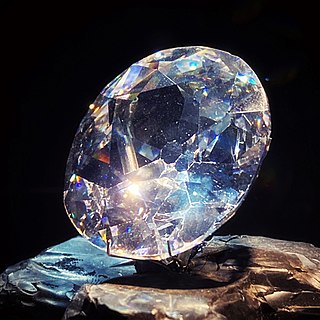
The Koh-i-Noor, also spelt Koh-e-Noor, Kohinoor and Koh-i-Nur, is one of the largest cut diamonds in the world, weighing 105.6 carats (21.12 g). It is part of the Crown Jewels of the United Kingdom. The diamond is currently set in the Crown of Queen Elizabeth The Queen Mother.

The Hope Diamond is a 45.52 carats diamond that has been famed for its great size since the 18th century. Extracted in the 17th century from the Kollur Mine in Guntur, India, the Hope Diamond is a blue diamond. Its exceptional size has revealed new information about the formation of diamonds.

The Peacock Throne was the imperial throne of Hindustan. The throne is named after the dancing peacocks at its rear and was the seat of the Mughal emperors of India from 1635 to 1739. It was commissioned in the early 17th century by Emperor Shah Jahan and was located in the Diwan-i-Khas in the Red Fort of Delhi. The original throne was taken as a war trophy by Nader Shah, Shah of Iran in 1739 after his invasion of India. Its replacement disappeared during or soon after the Indian Rebellion of 1857.
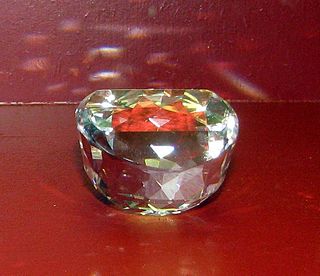
The Orlov, also often considered to be the same diamond known as The Great Mughal Diamond, is a large diamond of Indian origin, currently displayed as a part of the Diamond Fund collection of Moscow's Kremlin Armoury. It is described as having the shape and proportions of half a chicken's egg. In 1774, it was encrusted into the Imperial Sceptre of Russian Empress Catherine the Great.
Kollur Mine was a series of gravel-clay pits on the south bank of the Krishna River in the state of Andhra Pradesh, India. It is thought to have produced many large diamonds, known as Golconda diamonds, several of which are or have been a part of crown jewels.
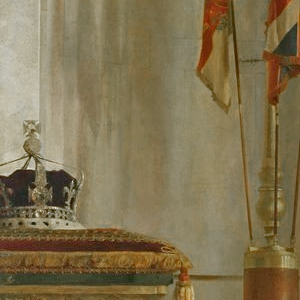
The Crown of Queen Elizabeth The Queen Mother, also known as the Queen Mother's Crown, is the crown made for Queen Elizabeth to wear at her coronation in 1937 and State Openings of Parliament during the reign of her husband, King George VI. The crown was made by Garrard & Co., the Crown Jeweller at the time, and is modelled partly on the design of the Crown of Queen Mary, though it differs by having four half-arches instead of the eight that Queen Mary's Crown originally had. As with Queen Mary's Crown, its arches are detachable at the crosses pattée, allowing it to be worn as a circlet or open crown. It is the only crown for a British king or queen to be made of platinum.

The Crown of Queen Mary is a consort crown that was made in 1911 for the coronation of British queen Mary of Teck. Mary thereafter wore it on occasion in circlet form. It is part of the Crown Jewels of the United Kingdom. It was used again, in a slightly altered form, at the coronation of Queen Camilla on 6 May 2023.

The Daria-i-Noor, also spelt Darya-ye Noor, is one of the largest cut diamonds in the world, weighing an estimated 182 carats. Its colour, pale pink, is one of the rarest to be found in diamonds. The diamond is currently in the Iranian National Jewels collection of the Central Bank of Iran in Tehran. During the reign of Naser al-Din Shah, an elaborate frame was crafted from 457 smaller diamonds and four rubies, crowned by Iran's imperial insignia. However, another theory posits that it is in a private collection in Bangladesh.

The Tavernier Blue was the precursor diamond to the Blue Diamond of the French Crown. Subsequently, most scholars and historians believed that it was re-cut and, after a disappearance and reemergence into the public forum, was renamed the Hope Diamond.

The Shah Diamond was found at the Golconda mines in what is now Telangana, South India, probably in 1450, and it is currently held in the Diamond Fund collection of Moscow's Kremlin Armoury.
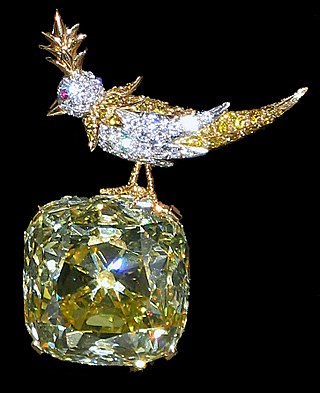
The Tiffany Yellow Diamond is one of the largest yellow diamonds ever discovered. Its carat weight was originally 287.42 carats in the rough when discovered in 1878 in the Kimberley mine in South Africa. It was cut into a cushion shape of 128.54 carats with 82 facets—24 more than a traditional round brilliant—to maximize its brilliance. The facet pattern features eight needle-like facets pointing outward from the culet (bottom) facet. Jewelry and diamond historian Herbert Tillander refers to this as a "stellar brilliant cut", and lists the gem in his book, Diamond Cuts in Historic Jewelry – 1381 to 1910 (1995), among other such diamonds: the Cullinan Diamond, the Koh-i-Noor, the Polar Star, the Wittelsbach, and others.

The Noor-ul-Ain is one of the largest pink diamonds in the world, and the centre piece of the tiara of the same name.

Ratti is a traditional Indian unit of measurement for mass. Based on the nominal weight of a Gunja seed, it measured approximately 1.8 or 1.75 grains or 0.1215 g as standardized weight. It is still used by jewellers in the Indian Subcontinent.

The Nassak Diamond is a large, 43.38 carats (8.676 g) Golconda Diamond that originated as a larger 89-carat diamond in the 15th century in India. Found in the Golconda mine of Kollur and originally cut in India, the diamond was the adornment in the Trimbakeshwar Shiva Temple, near Nashik, in the state of Maharashtra, India from at least 1500 to 1817. The British East India Company captured the diamond through the Third Anglo-Maratha War and sold it to British jewellers Rundell and Bridge in 1818. Rundell and Bridge recut the diamond in 1818, after which it made its way into the handle of the 1st Marquess of Westminster's dress sword.
Paritala is a village in the NTR district of the state of Andhra Pradesh, South India. It is located in Kanchikacherla mandal of Vijayawada revenue division.

The Timur Ruby is an unfaceted, 352.54-carat (71 g) polished red spinel set in a necklace. It is named after the ruler Timur, founder of the Timurid Empire and purportedly one of its former owners. It was believed to be a ruby until 1851.
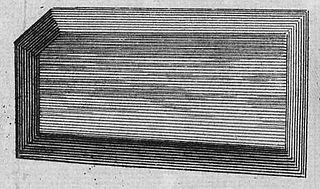
The Great Table was a large pink diamond that had been studded in the throne of the Mughal emperor Shah Jahan. It has been described in the book of the French jeweller Jean-Baptiste Tavernier in 1642, who gave it its name.

Golconda diamonds are mined in the Godavari-Krishna delta region of Andhra Pradesh, India. Golconda Fort in the western part of modern-day Hyderabad was a seat of the Golconda Sultanate and became an important centre for diamond enhancement, lapidary, and trading. Golconda diamonds are graded as Type IIa, are formed of pure carbon, are devoid of nitrogen, and are large with high clarity. They are often described as diamonds of the first water, making them among history's most-celebrated diamonds. The phrase "Golconda diamond" became synonymous with diamonds of incomparable quality.

Koh-i-Noor: The History of the World's Most Infamous Diamond is a 2017 book on the Koh-i-Noor diamond written by William Dalrymple and Anita Anand. The gem is one of the largest cut diamonds in the world, weighing 105.6 carats (21.12 g), and part of the British Crown Jewels. Koh-i-Noor is Persian for "Mountain of Light"; it has been known by this name since the 18th century. It was originally mined in South India long before the 13th Century CE, and changed hands between various factions in modern-day India, Pakistan, Iran, and Afghanistan, until being ceded to Queen Victoria after the Second Anglo-Sikh War, which resulted in the Punjab region falling under Company rule in 1849.
The Three Gemstones, also known as Three Mughal precious stones, were a group of gemstones that were found in 17th century in Mughal Empire during Mughal–Maratha War. The largest gemstone from three of them, according to historical facts, could be around 3,000-6,000 carats, it could be the largest ruby or sapphire that has ever been found.


















